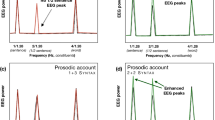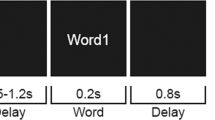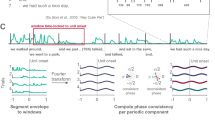Abstract
Spoken language, in contrast to written text, provides prosodic information such as rhythm, pauses, accents, amplitude and pitch variations. However, little is known about when and how these features are used by the listener to interpret the speech signal. Here we use event–related brain potentials (ERP) to demonstrate that intonational phrasing guides the initial analysis of sentence structure. Our finding of a positive shift in the ERP at intonational phrase boundaries suggests a specific on–line brain response to prosodic processing. Additional ERP components indicate that a false prosodic boundary is sufficient to mislead the listener's sentence processor. Thus, the application of ERP measures is a promising approach for revealing the time course and neural basis of prosodic information processing.
This is a preview of subscription content, access via your institution
Access options
Subscribe to this journal
Receive 12 print issues and online access
$209.00 per year
only $17.42 per issue
Buy this article
- Purchase on Springer Link
- Instant access to full article PDF
Prices may be subject to local taxes which are calculated during checkout





Similar content being viewed by others
References
Marslen–Wilson, W. S. et al. Prosodic effects in minimal attachment, Q. J. Exp. Psychol. 45A, 73–87 (1992).
Warren, P., Grabe, E. & Nolan, F. Prosody, phonology, and parsing in closure ambiguities. Lang. Cogn. Processes 10, 457– 486 (1995).
Stirling, L. & Wales, R. Does prosody support or direct sentence processing? Lang. Cogn. Processes 11, 193 –212 (1996).
Frazier, L. & Rayner, K. Making and correcting errors during sentence comprehension: Eye movements in the analysis of structurally ambiguous sentences. Cogn. Psychol. 14, 178– 210 (1982).
Frazier, L. in Attention and Performance XII: The Psychology of Reading (ed. Coltheart, M.) 559–589 (Erlbaum, London, 1987).
Taraban, R. & McClelland, J. R. Constituent attachment and thematic role assignment in sentence processing: Influence of context based expectations. J. Mem. Lang. 27, 597– 632 (1988).
Altman, G. T. M., Garnham, A. & Dennis, Y. Avoiding the garden–path: Eye movements in context. J. Mem. Lang. 31, 685– 712 (1992).
Cutler, A., Dahan, D. & van Donselaar, W. Prosody in the comprehension of spoken language: A literature review. Lang. Speech 40, 141– 201 (1997).
Blumstein, S. E. in The Cognitive Neurosciences (ed. Gazzaniga, M. S.) 915 –929 (MIT Press, Cambridge, MA, 1995 ).
Hagoort, P. & Kutas, M. in Handbook of Neuropsychology Vol.10 (eds. Boller, F. & Grafman, J.) 105–134 (Elsevier, Amsterdam, 1995).
Swaab, T. Y. The Functional Locus of Comprehension Deficits in Aphasia: An Electrophysiological Approach (Ponsen & Looijen, Wageningen, The Netherlands, 1996).
Osterhout, L. & Holcomb, P. J. Event–related brain potentials and syntactic anomaly: Evidence of anomaly detection during the perception of continuous speech. Lang. Cogn. Processes 8, 413–437 (1993).
Osterhout, L., Holcomb, P. J. & Swinney, D. A. Brain potentials elicited by garden–path sentences. Evidence of the application of verb information during parsing. J. Exp. Psychol. Learn. Mem. Cogn. 20, 786– 806 (1994).
Osterhout, L. & Holcomb, P. J. in Electrophysiology of Mind: Event–Related Potentials and Cognition (eds. Rugg, M. D. & Coles, M. G. H.) 171–215 (Oxford Univ. Press, Oxford, 1995).
Friederici, A. D., Steinhauer, K., Mecklinger, A. & Meyer, M. Working memory constraints on syntactic ambiguity resolution as revealed by electrical brain responses. Biol. Psychol. 47, 193–221 (1998).
Kutas, M. & Hillyard, S. A. Reading senseless sentences: Brain potentials reflect semantic incongruency. Science 207, 203–205 (1980).
Holcomb, P. J. & Neville, H. J. Natural speech processing: An analysis using event–related brain potentials. Psychobiology 19, 286–300 (1991).
Kutas, M. & van Petten, C. in Handbook of Psycholinguistics (ed. Gernsbacher, M. A.) 83–143 (Academic, San Diego, 1994).
Friederici, A. D., Steinhauer, K. & Frisch, S. Lexical integration: Sequential effects of syntactic and semantic information. Mem. Cogn. (in press).
Nespor, M. & Vogel, I. Prosodic Phonology (Foris, Dordrecht, 1986).
Selkirk, E. O. Phonology and Syntax: The Relation between Sound and Structure (MIT Press, Cambridge, 1984).
Halle, M. & Vergnaud, J. R. An Essay on Stress (MIT Press, Cambridge, 1987).
Gernsbacher, M. A. & Jescheniak, J. D. Cataphoric devices in spoken discourse. Cogn. Psychol. 29, 24–58 (1995).
Rösler, F., Friederici, A. D., Pütz, P. & Hahne, A. Event–related brain potentials while encountering semantic and syntactic constraint violations. J. Cogn. Neurosci. 5, 345–362 (1993).
Friedman, D., Simson, R., Ritter, W. & Papin, I. The late positive component (P300) and information processing in sentences. Electroencephalogr. Clin. Neurophysiol. 38, 255–262 (1975).
Van Petten, C. & Kutas, M. Influences of semantic and syntactic context on open– and closed–class words. Mem. Cogn. 19, 95–112 ( 1991).
Osterhout, L. & Hagoort, P. A superficial resemblance doen't necessarily mean that you're part of the family: Counterarguments to Coulson, King, and Kutas (1998) in the P600/SPS–P300 debate. Lang. Cogn. Processes (in press).
Friederici, A. D. The time course of syntactic activation during language processing: A model based on neuropsychological and neurophysiological data. Brain Lang. 50, 259–281 ( 1995).
Hopf, J.–M., Bayer, J., Bader, M. & Meng, M. Event–related brain potentials and case information in syntactic ambiguities. J. Cogn. Neurosci. 10, 264–280 (1998).
Bader, M. in Reanalysis in Sentence Processing (eds. Ferreira, F. & Fodor, J. D.) (Kluwer, Dordrecht, in press).
Beckman, M. E. The parsing of prosody. Lang. Cogn. Processes 11, 17–67 (1996).
Fodor, J. D. Learning to parse? J. Psycholinguistic Res. 27, 285–319 (1998).
Ross, E. D. in Behavioral Neurology and Neuropsychology (eds. Feinberg, T. E. & Farah, M. J.) 699–709 (McGraw–Hill, New York, 1997).
Oldfield, R. C. The assessment and analysis of handedness: The Edinburgh inventory. Neuropsychology 9, 97–113 (1975).
Regan, D. Human Brain Electrophysiology: Evoked Potentials and Evoked Magnetic Fields in Science and Medicine (Elsevier, New York, 1989).
Huynh, H. & Feldt, L. A. Conditions under which mean square ratios in repeated measurement designs have exact F–distributions. J. Am. Stat. Assoc. 65, 1582–1589 (1979).
Keppel, G. Design and Analysis: A Researcher's Handbook (Prentice–Hall, Englewood Cliffs, New Jersey, 1991).
Acknowledgements
We appreciate the comments of Lee Osterhout and Gerry Altman on an earlier version of the manuscript. We also thank Katja Kühn, Annett Schirmer and Franziska Kopp for their assistance in generating the stimulus materials and in analyzing the signals. This work was supported by the Deutsche Forschungsgemeinschaft (FR 519/17–1).
Author information
Authors and Affiliations
Corresponding author
Rights and permissions
About this article
Cite this article
Steinhauer, K., Alter, K. & Friederici, A. Brain potentials indicate immediate use of prosodic cues in natural speech processing. Nat Neurosci 2, 191–196 (1999). https://doi.org/10.1038/5757
Received:
Accepted:
Issue Date:
DOI: https://doi.org/10.1038/5757
This article is cited by
-
Overt and implicit prosody contribute to neurophysiological responses previously attributed to grammatical processing
Scientific Reports (2022)
-
The process of linguistic understanding
Synthese (2021)
-
Rhythmic pattern facilitates speech production: An ERP study
Scientific Reports (2019)
-
Language and music phrase boundary processing in Autism Spectrum Disorder: An ERP study
Scientific Reports (2017)



